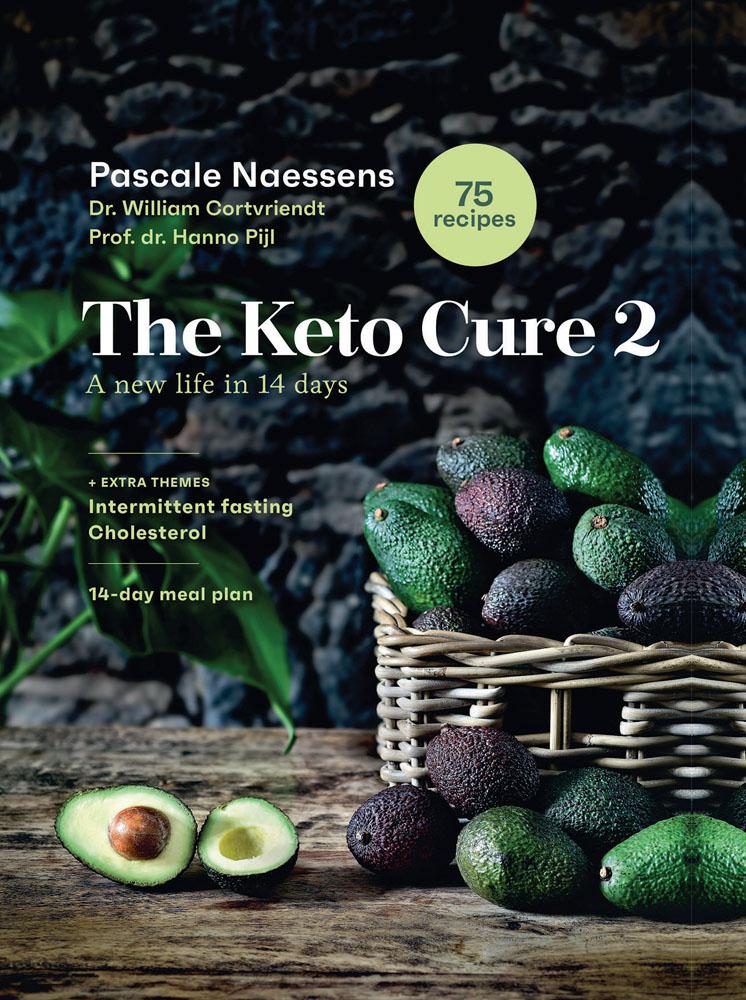

One of the many beautiful views of Lanzarote, where most of the photographs in this book were taken.



One of the many beautiful views of Lanzarote, where most of the photographs in this book were taken.

“What you described: ‘A new life in 14 days’, has come true. After two weeks, I had lost three kilos, and after four weeks almost five kilos—without feeling hungry! All that while I’m going through menopause. And my guests at the table enjoy the meals as much as I do! The funny thing is my eating habits have really changed. Thank you, Pascale, this was a huge eye-opener for me. Warm regards.”
Annushka, a reader
Keto is more popular than ever!
How do my keto recipes differ from most other recipes?
Why do I use existing recipes from other books in The Keto Cure 2?
What is a ketogenic diet? A summary
Why does the ketogenic diet work?
How can you lose weight while eating so much and so many calories?
Why I’m a proponent of a ketogenic diet and of “cycling” your diet
How much fat, protein and carbs am I allowed to eat while following a ketogenic diet?
To track or not to track macros
How about dessert?
Intermittent fasting
How do I transition from keto to low carb?
How much fat should I eat after being on a ketogenic diet?

The recipes in this book are for two people, unless indicated otherwise.
But listen to your body: if you’re hungry, eat more. If you’re full, stop eating.
Prof. Dr. Hanno Pijl: “Intermittent fasting and time-restricted eating”
Dr. William Cortvriendt: “The ketogenic diet and misconceptions about cholesterol”
14-DAY

Breakfast – Appetizer – Lunch – Dinner – Dessert
Your body is not your enemy, and willpower is not your friend I’m doing everything right, but I’m not losing weight! Go nuts – Go seeds
The power of the cauliflower is its versatility Avocados on the cover
All ceramics in the book were designed by Pascale Naessens. Besides being an author she is also a ceramist.
You can find her creations via Pure Tableware by Pascale Naessens for Serax or via her website www.purepascale.com

Honestly, I hadn’t expected The Keto Cure to be such a success. It was Belgium’s best-selling cookbook in 2020! I was particularly surprised that so many people are interested in this specific diet. Many are wildly enthusiastic, while others are nonplussed. People are enthusiastic because they lose excess weight and particularly because they can continue to eat delicious food and don’t feel hungry. The weight loss was spectacular for some people and more subtle for others. This immediately shows how different we all are. The realization that we all react differently to food is steadily growing. That’s something I applaud wholeheartedly: it’s something I’ve been drawing attention to ever since my first book.
The idea that we all should eat the same way is outdated and no longer a scientific given. People are becoming increasingly aware that they need to find a way of eating that suits them, both in terms of their bodies and their genetic dispositions.
A Facebook group was set up as a follow-up to the book The Keto Cure. If you want to follow a ketogenic diet, I would certainly recommend joining the group; you learn a lot from each other, and you immediately get a sense of what keeps keto enthusiasts busy.
If keto is completely new to you, then I recommend reading The Keto Cure first. This book contains the basics and an explanation of what the ketogenic process is, how to get started on
your keto journey, the benefits and disadvantages, why it’s such a controversial diet, and much more. In The Keto Cure 2, we go more in-depth into the questions people have once they start eating keto.
There have also been a lot of questions about intermittent fasting. That’s why I’ve asked Prof. Hanno Pijl, who is himself adept at intermittent fasting, to deal with this topic in-depth. What are the health benefits of intermittent fasting and what’s known as time-restricted eating?
And, perhaps the most frequently asked question: “Help, my cholesterol levels increase with keto. Should I be worried?” What’s the story with cholesterol? Do high cholesterol levels really lead to cardiovascular disease? What are the latest insights on the subject? That’s what I asked Dr. William Cortvriendt. He delved into the recent science on this topic and provides clear answers to these questions.
The Keto Cure 2 is another fascinating book, with a new 14-day keto meal planner and extra recipes for continuing your keto cure so you can once more immerse yourself in the wonderful world of the ketogenic diet.
I wish you an exciting journey full of discovery and inspiration.
Pascale



A varied diet is the best guarantee of a healthy and fit body. That means that you’ll find plenty of vegetables, nuts and seeds in my books, but also fish, meat, eggs, cheese and healthy fats, all produced from unprocessed or minimally processed ingredients.
But vegetables continue to form the basis of my recipes. That’s perhaps the biggest challenge when developing my keto recipes. It’s not easy to create delicious, simple and appealing keto recipes where vegetables take center stage because they are usually rich in carbs, and the whole point is to eat as few carbs as possible.
But vegetables are perhaps even more critical with a ketogenic diet; they’re the best source of fiber you have in this case. Fiber is essential for the proper functioning of your gut, your microbiome and your feeling of well-being. Vegetables also provide plenty of vitamins and secondary plant nutrients that all contribute to your health.
As someone who loves to cook, I would like to add that vegetables, above all ingredients, leave room for creativity: they add flavor, color and texture and can be combined to create the most surprising results ... They make food fun, playful and varied.
That’s why I’ve challenged myself to create recipes that meet all the requirements. Not only are they low on carbs but also include moderate quantities of protein and healthy fats. Because when you eat keto, you should also eat delicious, nutritious and varied foods.
So the question remains: why would you want to stay in ketosis if you can reap many of the same health benefits from a moderately low-carb way of eating, such as weight loss (when you’re overweight), more energy, a clear mind, stable insulin and blood sugar levels ...
Before you start cycling, you first need to become fat-adapted. This means that your body will choose fat over glucose as a source of energy. You do this by following a strict keto diet for at least 14 days or three weeks. Then you gradually switch to a moderately low-carb way of eating. Your body will still burn fats optimally.
Possible ways to cycle
There are many ways you can cycle your diets. You can, for example, go keto during the week and switch to low-carb on the weekends. Or you can generally eat low-carb and throw in a week of keto here and there. Or keep switching between keto and low-carb like I do. First of all, I choose quality food. I don’t consciously say, “Okay, now I’m going to eat low-carb,” or “now I’m going to eat keto.” On the days that I don’t have fruit for breakfast, or just some berries with full-fat yogurt and nuts (like I do in the summer), or a hearty breakfast with eggs, and I eat few carbs in the afternoon or evening, I’m in a mild state of ketosis in no time. I always eat low-carb, and sometimes that happens to be keto, and sometimes it doesn’t. I don’t plan anything. I just eat what I feel like, but I seldom or never eat fast carbs.
There is a difference between nutritional ketosis and medicinal ketosis
Most people follow a ketogenic diet to lose weight. That’s what we call nutritional ketosis. Some people choose or must follow a ketogenic diet for health reasons, in which case we call it medicinal ketosis. One example is epilepsy patients, for whom the diet was initially developed. Research is also currently being conducted into the health benefits for Alzheimer and cancer patients. The ketogenic diet can have a beneficial effect on some types of cancer, but not all, and this field still requires a lot of research. In those cases, patients are always monitored medically.

How much fat, protein and carbs am I allowed to eat while following a ketogenic diet?
How many carbs am I allowed to eat while following a ketogenic diet?
The answer to this is straightforward: as many as you want without falling out of ketosis. For most people, that’s between 30 and 50 grams of carbohydrates per day. The more insulin-resistant you are, the harder it is to reach ketosis and the fewer carbs you’re allowed to eat. Once you’re fatadapted and your body has adjusted to optimal fat

burning, you can eat slightly more carbs. You can also eat slightly more carbs after exercise. Which carbs you should eat are discussed in The Keto Cure.
How much fat am I allowed to eat while following a ketogenic diet?
With keto, you’re allowed to be generous with fat. Still, I’ve noticed that some people in our “Keto Cure” Facebook group were a bit too generous with fat; they were adding extra fat to everything, and that’s taking it a bit too far. What role do fats play in a ketogenic diet?
First and foremost, you should know that it’s not the extra fats that help you reach ketosis but the absence of carbs. Fasting, together with training, is probably the fastest way to reach ketosis, and that doesn’t involve eating fats.
So why should we eat more fats while following a ketogenic diet?
We take away practically all carbs, so we need to eat something else to replace them. Otherwise, you would eat very little, be constantly hungry, and give up in no time. So we replace the carbs with fats, and that works out well because we want your body to burn fats—and your own body fat with it.
People who are in ketosis burn twice as much fat as usual. However, if you take in too much fat, you will never get around to using up your fat reserves, and you won’t lose weight. If you take in too little fat, your body will start to break down its muscles to get the energy it needs. See fat as your new source of energy. And, as with everything else, finding the right balance is key. If you want to lose weight and
you’re not losing weight, use a little less fat. If you don’t have to lose weight, you can consume a little more fat. But the goal is not to eat extra fats; just eat the fats that are part of a full nutritional diet. If your piece of meat has fat on it, don’t cut it away, but eat it instead. Use milk products that have not been skimmed, such as full-fat yogurts and cheeses. Don’t be afraid to eat fat-rich products such as nuts, fatty fish, avocados ... And you can be generous with olive oil. Use fat as a flavor enhancer and to give you that full feeling.
The idea is that, just like with everything in your diet, you vary your fat intake. Polyunsaturated fats are essential. We usually consume more than enough omega-6 fats, so concentrate on the omega-3 fats found in fish and shellfish. These fats are exceptionally good for your heart, your brain and cell generation, have anti-inflammatory properties, and are promoted by scientists researching longevity.
The following may surprise you: the fats that can be most quickly converted into energy are the mono-unsaturated fats, found in olive oil, for example, and saturated fats, which you find in butter, coconut oil, full-fat yogurt or cream, but also in bacon (which is half saturated and half mono-unsaturated fat).
So olive oil continues to be a first-class ingredient in this diet. And you don’t need to be afraid of saturated fats.
Once you’re fat-adapted, you use twice as much fat as an energy source as you used to. These fats are not stored in the body (unless you eat too much fat), and they don’t clog up your arteries;
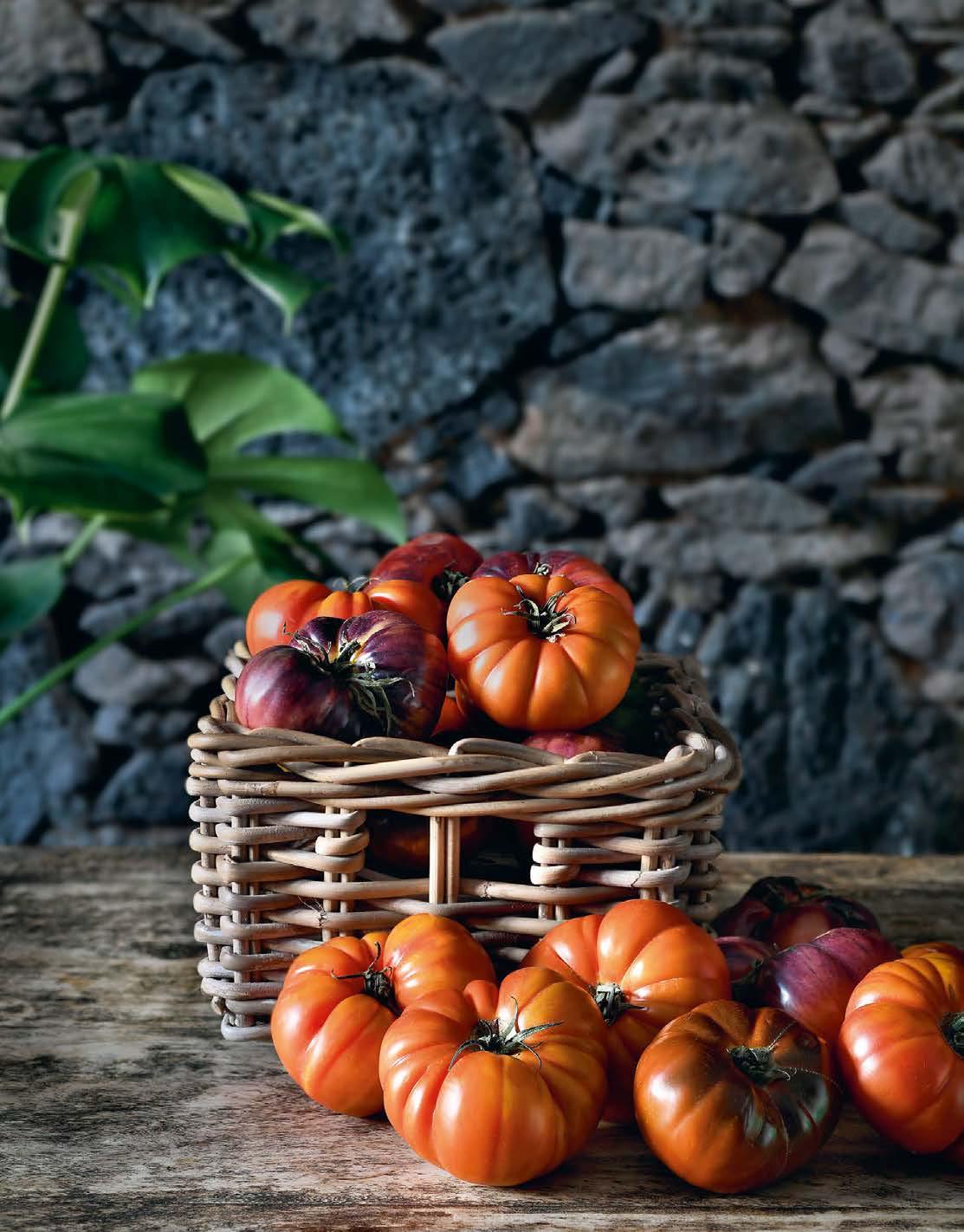


Intermittent fasting
We’ve known for about 80 years that limiting food increases the lifespan of rats under laboratory conditions. Give them 30% less than the control group (who are given as much as they want), and they clearly not only age more slowly, but they remain healthier as they do so. For example, cancer is far less prevalent among the animals who were given less to eat. Why is that? And does limiting food intake have a similar effect on people? And even if it does work, always eating less than you actually want is an enormous challenge, particularly in a society that constantly tempts us to consume food. Is periodically fasting a more feasible alternative? And does it matter when you eat? Those are the questions that we’ll try to answer in this book.
Why eating makes us age
There have been hundreds, if not thousands, of studies with a variety of animal species (from worms to mice and apes) that all show similar results: eating less than “normal” in the
lab increases lifespan and reduces the chance of (chronic) diseases. Ageing and chronic disease result from damaged cells and tissues. So how does eating less than normal under laboratory conditions lead to reduced cell damage?
Firstly, it’s important to define what we mean by “normal” in this context. Animals in the lab generally are given more than enough food. They eat until they’re full, and sometimes more (just like people who are offered food they like). There are scientists who suggest that restricting food in captivity actually prevents the harmful effects caused by overeating. But why is overeating bad? The initial logical thought is that overeating leads to being overweight, and we all know that being overweight is not healthy. But there’s more to it than that.
When we eat something, it’s nearly always followed by an inflammatory response in the body. That response is necessary to repair the damage caused by our metabolism processing the food. Processing food costs energy. When the power plants in our cells, the mitochondria,


When I talk to dieticians and physicians about the ketogenic diet, I often hear comments like the following: “It’s a diet with an awful lot of fat,” or “That can’t be healthy.” Usually followed by a comment that such a diet increases cholesterol levels in the blood leading to an increased risk of cardiovascular disease. They’re right in saying that the ketogenic diet contains a lot of fat—70 to 75 percent even— including plenty of saturated fats. And these fats increase the cholesterol level in the blood. In that respect, those comments are completely correct. However, the premise that so many fats and a raised cholesterol level are by definition unhealthy is not. Consuming plenty of fat is actually very healthy, as long as they’re the right fats. And a high cholesterol level doesn’t have to be unhealthy, especially when it’s the result of a ketogenic diet. In short, it’s time to set some things straight about healthy and unhealthy fats and the cholesterol phenomenon.
Concerns about increasing heart attack rates
Over the course of many millions of years of evolution, our genes have always been able to adapt to what were usually slowly-changing environmental factors. Over the last century, however, the amount of carbs in our diet has skyrocketed, most notably as a component of industrially processed foods, sodas and juices. Increasing quantities of sugar and industrial trans fats were used to flavor these processed foods. Trans fats in particular were used because these fats don’t go rancid like their natural counterparts and increase the shelf life of a product. Our genes haven’t had enough time to adjust to these kinds of changes.
Because of a rapid increase in the number of fatal heart attacks, governments in western countries became increasingly concerned about what their citizens ate after the Second World War. The suspicion had arisen that the fats and cholesterol in our food were the cause of cardiovascular disease. They noticed that every time a patient died from a heart attack and the blood vessels were inspected, it turned out that these were clogged up because the blood vessel lining

was filled with fats and cholesterol. So the inevitable conclusion was that these components in our nutrition were the culprits. It was around the same time that the worldfamous American nutrition expert Ancel Keys came up with the idea of seeing if there was a correlation between fat consumption in different countries and the number of fatal heart attacks. He hypothesized that fatal heart attacks would be more prevalent in countries with the highest fat consumption. Keys passionately devoted most of his career to finding proof to support his hypothesis. The published results became known as the so-called “Seven Countries Study”, in which he illustrated the correlation between the consumption of mainly saturated fats and cholesterol levels in the blood in certain countries on the one hand, and on the other hand the number of deaths related to cardiovascular disease. This study was later highly criticized for a number of reasons. First of all, the original study did not contain 7 countries but 21 countries—14 countries had been removed from the study because their findings did not agree with the hypothesis that fats and cholesterol were responsible for cardiovascular disease. In fact, later studies revealed that there wasn’t a single correlation between the number of deaths caused by heart failure and fat consumption, but that there was a correlation between heart failure and the consumption of sugar, cake and other baked goods containing high carbohydrate levels.
Government nutritional guidelines from 1977 onwards and their consequences
Despite the fact that, in hindsight, Keys’ conclusions were incorrect, they were adopted across the globe by governments, physicians, dieticians and even the WHO. In the US in 1977, there was even a formal directive from what was then called the McGovern senate committee to restrict the consumption of fats and replace fats with carbohydrates with the aim of reducing the risk of cardiovascular disease. This advice led to a rapid increase in the consumption of carbohydrates and a decrease in what had become relatively expensive fruits and vegetables. And the food industry immediately followed suit by stocking supermarket shelves with industrially processed food filled with sugars and other carbs. Natural fats and cholesterol were removed from foods wherever possible and partially replaced by linoleic acid, a so-called polyunsaturated fat that was supposed to be good for the heart and blood vessels. We were introduced to new terms such as “cholesterol-free”, “reduced-fat”, “fat-free”, “skimmed”, and “light”. The desired result, a decrease in the number of heart attacks, however, was not achieved with the guidelines offered by the McGovern senate commission, not even when the desired lower cholesterol levels in the blood were detected. What did happen was that, immediately after the publication of this advice, in the US, overweight, obesity, and a few years later type 2 diabetes, started their irrevocable increase, later followed by an increase in cardiovascular disease and cancer. And wherever in the world the same guidelines were followed—including the Netherlands and Belgium— the same trends arose as in the US.
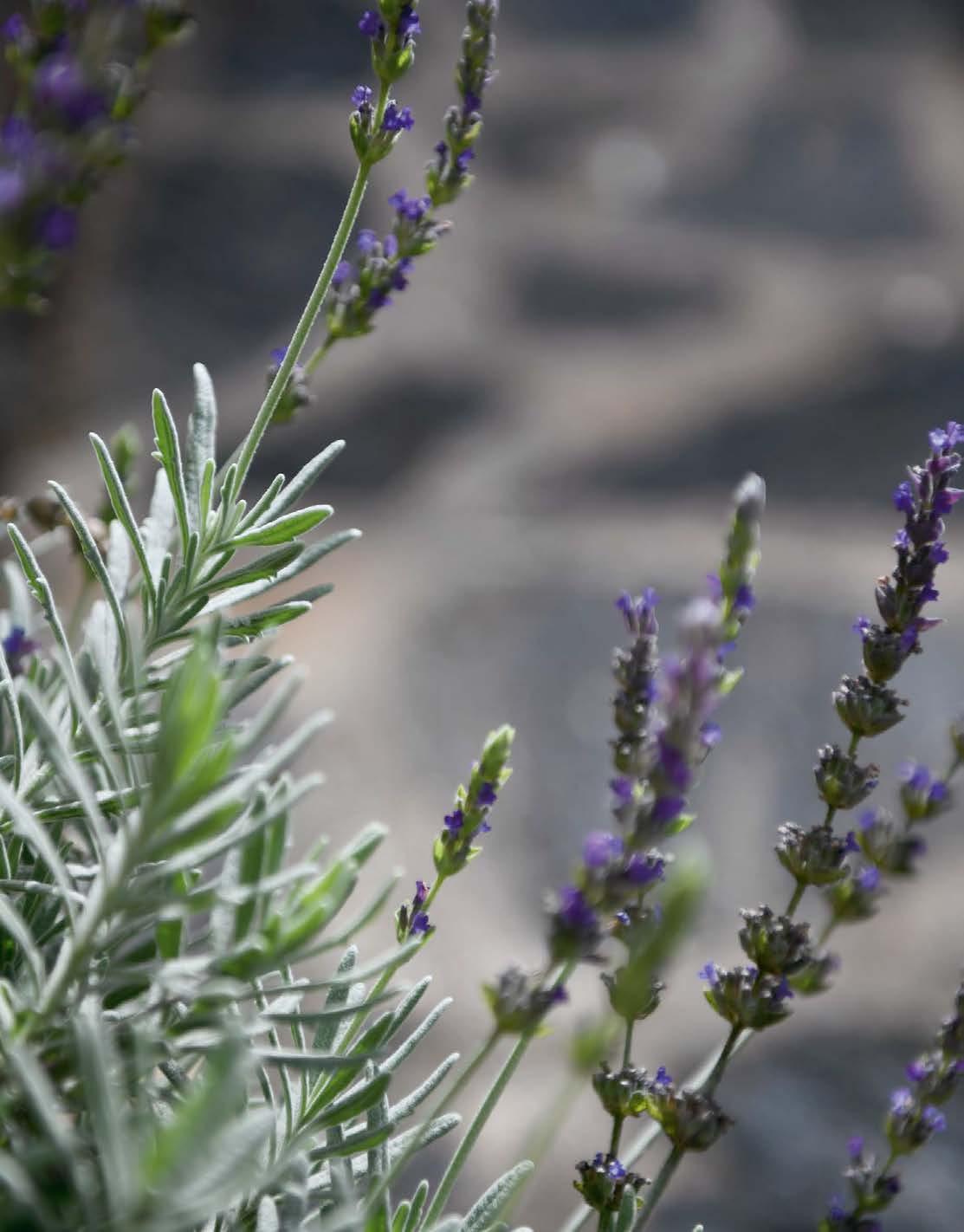
I took the photographs for this book on the island of Lanzarote. The beautiful light and amazing natural surroundings made it an absolute delight to take pictures.

Day 1
BREAKFAST LUNCH
DINNER
Delicious omelet with salmon and fresh herbs
I’ve created a varied menu, but know that you can switch some of the recipes with alternatives from the “Extra recipes” chapter.
Sauteed pointed cabbage with juicy cherry tomatoes and melted feta
Chicken soup with vegetables

Day 2
BREAKFAST LUNCH
DINNER
Cheese waffles
Broccoli soup with halloumi and a Parmesan cheese and walnut crumble
Fried fish with creamy spinach, tomatoes and olives
Day 3
BREAKFAST LUNCH
DINNER
Seeds and nuts
Sautéed vegetables with egg and bacon
Hamburger casserole with a lovely thick cauliflower mousse
Day 4
BREAKFAST LUNCH
DINNER
Chocolate mousse with avocado
Tabouleh salad
Cauliflower risotto with halloumi and Parmesan cheese
Day 5
BREAKFAST LUNCH
DINNER
Five-minute broccoli omelet
Large portobello with spinach, tomatoes and cheese
Jumbo shrimp with ras-el-hanout and vegetables
Day 6
BREAKFAST LUNCH
DINNER
Delicious cheese-nut bread with olive oil and herbes de Provence
Greek salad with cauliflower rice and feta cheese
Thai minced beef curry with vegetables
Day 7
BREAKFAST LUNCH
DINNER
Delicious cheese-nut bread with olive oil and herbes de Provence
Delicious salad with squid, avocado and lumpfish roe
Peanut-coated fried fish with salad
Day 8

Day 9
BREAKFAST LUNCH
DINNER
Coconut breakfast cake with blueberries
Avocado with feta and a salad
Fried chicken with mushrooms and Brussels sprouts
BREAKFAST LUNCH
DINNER
Classic omelet with vegetables
Mackerel with avocado and greens
Salmon with a lemon-butter sauce and stir-fried vegetables
Day 10
BREAKFAST LUNCH
DINNER
Coconut milk with nut paste, strawberries and a nut crumble
Cauliflower puree with green beans and a poached egg
Shredded pointed cabbage in a creamy cheesy mushroom sauce
Day 11
BREAKFAST LUNCH
DINNER
Frittata with spinach and mushrooms
Spinach with feta and turmeric
Fancy chicken with cauliflower
Day 12
BREAKFAST LUNCH
DINNER
Frittata with spinach and mushrooms
Nori with crayfish and avocado
Endive au gratin with ham in a cauliflower sauce
You can find the shopping lists on purepascale.com or on the Keto Cure Facebook group page.
Day 13
BREAKFAST LUNCH
DINNER
Fluffy rolls with ham, cheese …
Poke bowl with salmon and cauliflower rice
Asian-style soup with mushrooms and shrimp
Day 14
BREAKFAST
Smoked salmon with avocado, mascarpone and lumpfish roe
(with fluffy rolls if you wish)
LUNCH
DINNER
Sautéed eggplant with brown shrimp and roasted pine nuts
Sauerkraut with bacon and sausage
Preparation time: 10 to 15 minutes – Cooking time: 40 minutes

Serves 4
7 oz (200 g) ground almonds (see tip)
7 (200 g) grated Emmental cheese
2 tablespoons mascarpone (2 oz/60 g)
2 eggs
1 teaspoon baking soda (see tip on page 215) herbes de Provence (thyme, rosemary...)
This cheese
and
nut bread is delicious.
Also ideal for lunch on the go. You can eat the bread as it is or top it with some extra cheese or whatever you feel like.
This is also tomorrow’s breakfast, which is why we’re making a large batch.
Preheat the oven to 350 °F (180 °C).
Combine the ground almonds with the baking soda, season with pepper and a little salt and add the herbes de Provence.
Stir in the mascarpone and the eggs.
Knead the cheese into the nutty flour.
Shape the dough into an oval ¾ inches (1.5 cm) thick. Score the dough crossways and sprinkle plenty of olive oil over the top. Sprinkle some additional herbes de Provence over the top and bake in the oven for 40 minutes.
Tip: warm or cold
This cheese bread is at its best when served at room temperature. My advice is to bake an extra-large batch. The bread will keep up to 3 days in the refrigerator or longer in the freezer. In both cases, heat the bread briefly in the oven before serving. You’ll have a delicious breakfast ready in no time. You can top the bread with cheese or another topping, but it tastes just fine as it is.
ground almonds
Some people are a bit fed up with the taste of almonds, and if you’re not a huge fan of the flavor, that makes perfect sense. But did you know that you can always replace almonds with other kinds of nuts? Hazelnuts are a delicious alternative. Grind them yourself or buy pre-ground hazelnuts in the store.
Per serving: 30.8g P (19%) / 3.3g NetC (2%) / 56.8g F (79%)
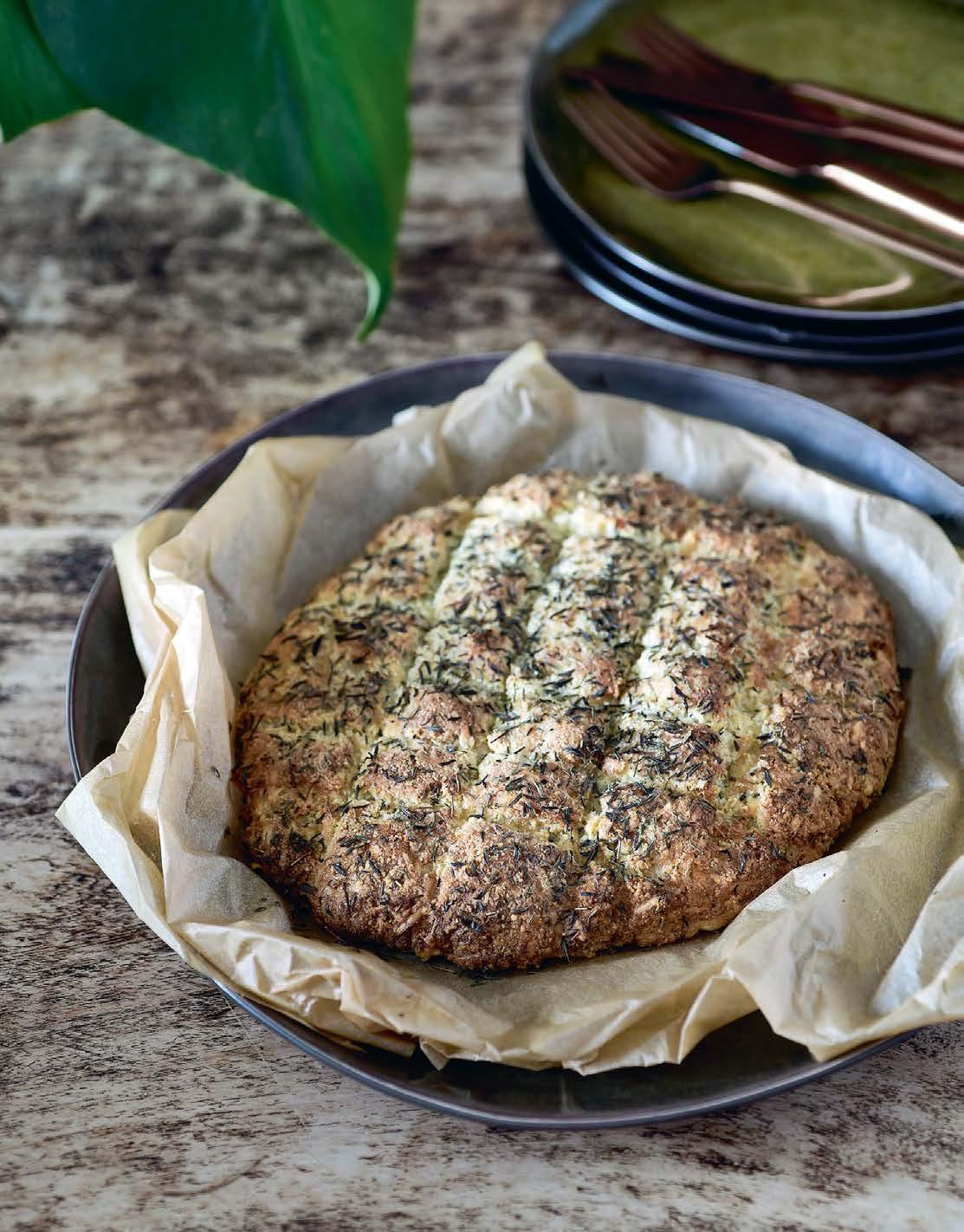
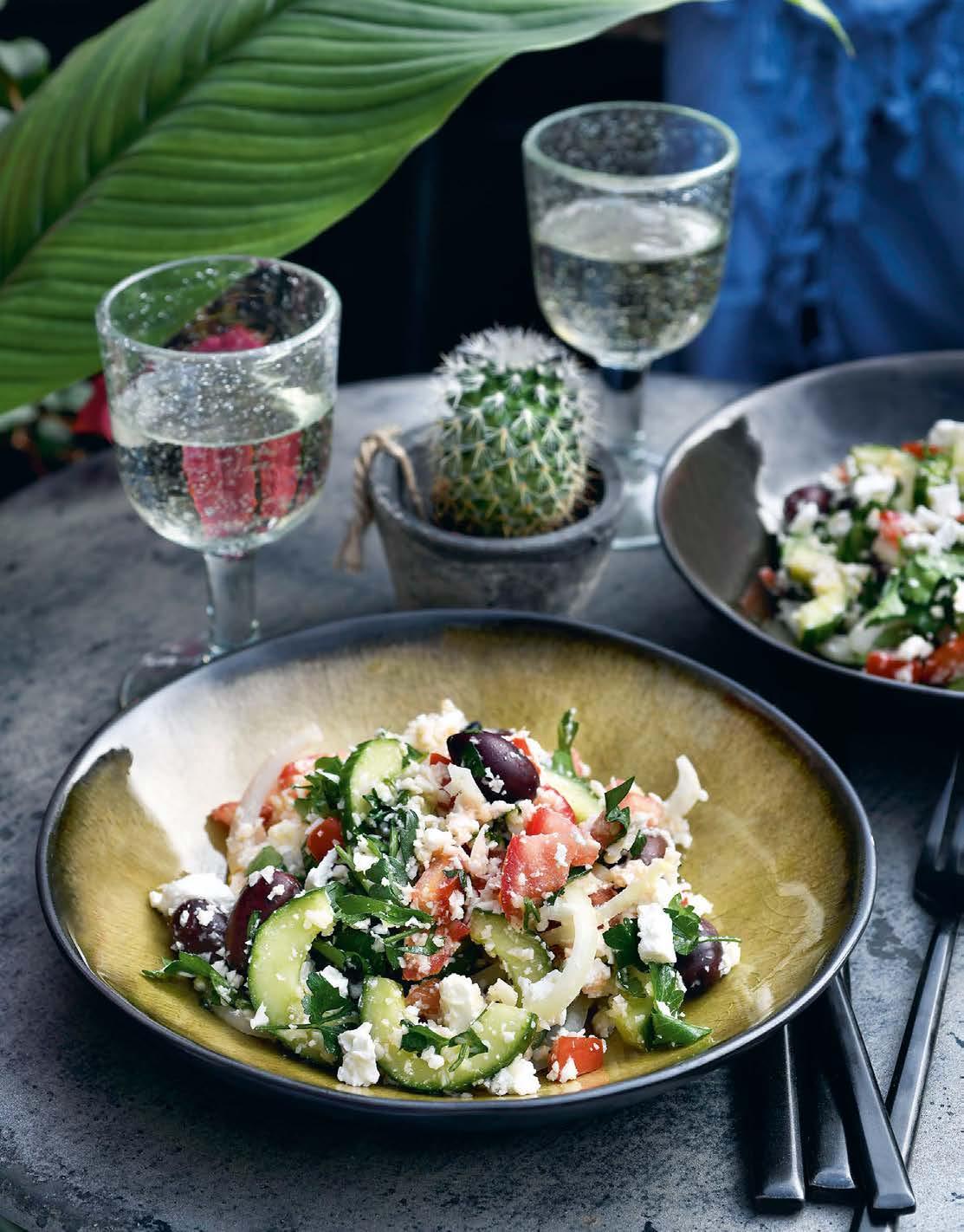
This
is one of my favorite salads, full of vegetables and rich in flavor. Delicious.
Preparation time: 15 minutes – Cooking time: 5 minutes
5 oz (150 g) cauliflower
a handful olives (3 ½ oz/100 g)
1 large tomato (7 oz/200 g)
1 small onion (2 oz/60 g)
6-inch (15 cm) piece of cucumber (about 5 oz/150 g) handful of flat-leaf parsley
1 packet feta cheese (7 oz/200 g – see tip)
1 lemon

Coarsely chop the cauliflower in a food processor and put the pieces in a pan with 2 tablespoons olive oil, salt and pepper. Stir-fry the cauliflower al dente in a couple of minutes. Quarter the tomatoes, remove the seeds and catch the juice through a sieve. Dice the flesh into pieces. Cut the cucumber lengthways in two and scrape out the seeds with a spoon. Slice the flesh into half-moons. Finely chop the parsley and cut the onion into strips. Put all the vegetables and olives in a bowl, season with salt and pepper and combine well. Crumble the feta over the top.
Combine the tomato juice with the juice of ½ lemon and add 4 tablespoons (1 oz or 24 grams) olive oil. Pour the vinaigrette over the salad. Serve with a wedge of lemon.
If the portions are generally too large for you or if you’re feeling less hungry, use half a packet of feta instead. The opposite also applies; if you’re hungry, use more.
Per serving: 19.6g E (11.7%) / 10.2g NetC (6.1%) / 61g F (82.2%)
Preparation time: 15 minutes – Cooking time: 20 minutes
10 ½ oz (300 g) minced beef
1 small onion (2 ¼ oz/70 g)
3 ½ oz (100 g) green beans
7 oz (200 g) pointed cabbage
5 oz (150 g) coconut milk
1 tablespoon red curry paste (1 oz/30 g)
flat-leaf parsley (to garnish)

Slice the beans in half and cook them until tender in a little water with some olive oil (½ oz/15 grams). Cover the pan. Coarsely chop the cabbage and add to the pan. Season with some salt and pepper. Cover again. Check occasionally to make sure the vegetables don’t dry out. If they’re dry, add a little extra water and/or olive oil.
Season the meat with salt and pepper and form it into 8 meatballs. Fry them in a pan with a little butter (¾ oz/20 grams). Coarsely chop the onion and add to the pan. Once the meat has browned and the onions are soft, add the coconut milk together with the red curry paste. Cook a little longer.
Turn down the heat.
Drain the vegetables and add them to the curry. Serve in deep dishes and garnish with some fresh herbs such as flat-leaf parsley.
Be careful with curry paste: curry pastes can be very spicy depending on which brand you use. The key is to keep tasting. Also, choose a low-carb curry paste. The purer the curry paste, the fewer carbs it contains. :-)
Per serving: 37g P (27.8%) / 9.4g NetC (7.1%) / 38.6g F (65.1%)
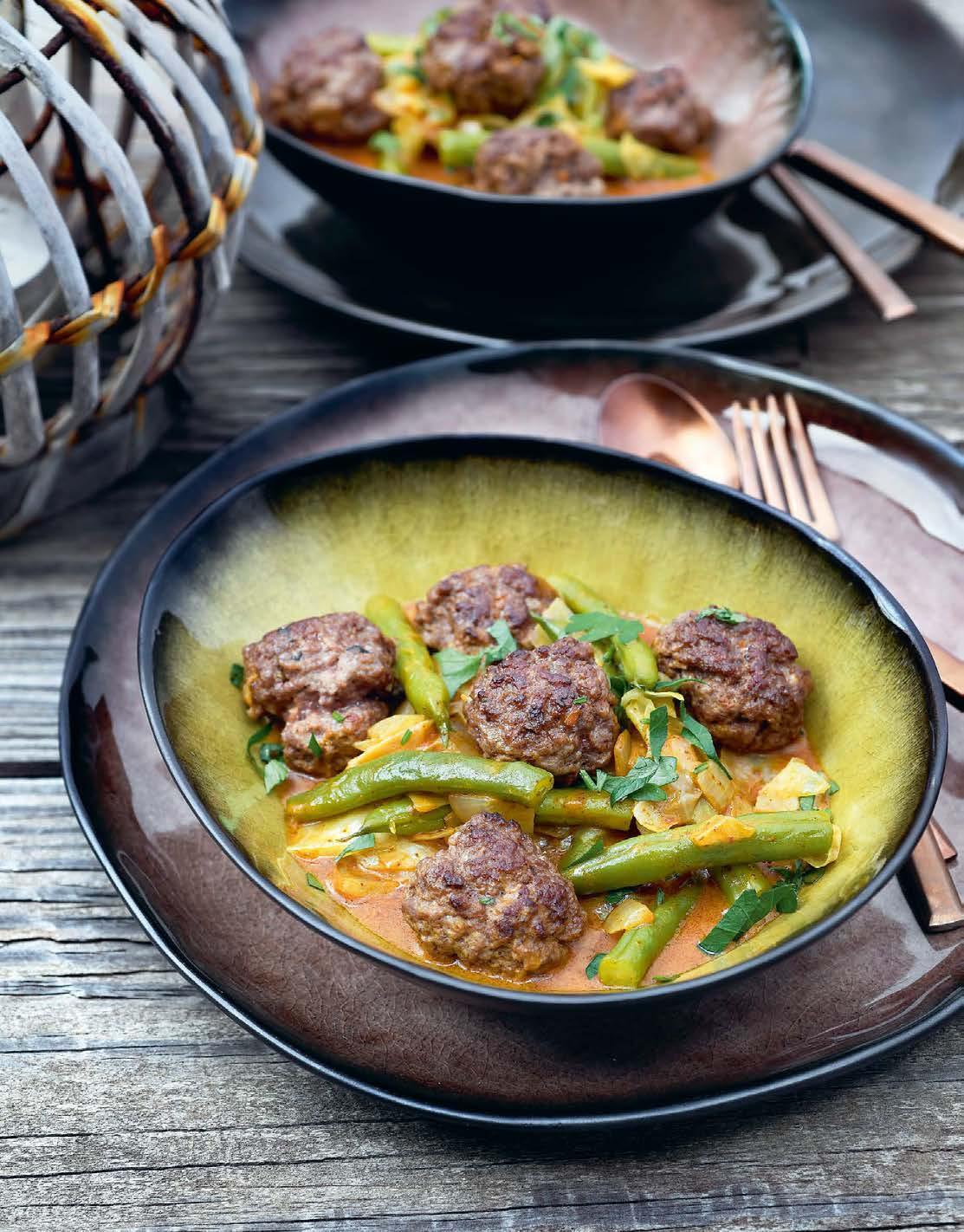
This recipe is always a favorite for any occasion.
www.pascalenaessens.com
www.lannoo.com

Have you had good experiences with this way of eating? We’d love to hear about it. Visit the website mentioned above and send us a message via the “contact” page. You can read more stories under the header “testimonials”. United we stand!
RECIPES, STYLING AND CONCEPT
Pascale Naessens
TEXTS
Pascale Naessens, Hanno Pijl, William Cortvriendt
ENGLISH TRANSLATION
Textcase, Deventer
RECIPE MACRONUTRIENT CALCULATIONS
Dietician Sabrina Mattens
PHOTOGRAPHY
Roos Mestdagh, Diego Fransens, Ramon De LLano
DESIGN
Leen Depooter – quod. voor de vorm.
If you have any comments or questions, please do not hesitate to contact the publisher: redactielifestyle@lannoo.be
© Pascale Naessens and Lannoo Publishers, Tielt - Belgium, 2022
D/2022/45/119 – NUR 440-441
ISBN: 978 94 014 8223 3
All rights reserved. No part of this publication may be reproduced, stored in a retrieval system and/or publicized in any form or by any means, electronic, mechanical, or otherwise, without the prior written permission of the publisher.